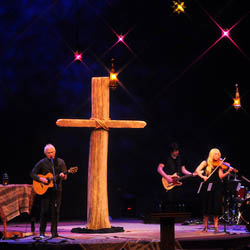
Stay Organized
Some like to start from the bottom (drums and bass) and work their way up to the top (vocals).
Others work in reverse order. Personally I prefer and normally do the former, but which way you go is up to you, and depends on your situation.
Whatever you do, stay organized. Don’t start with the kick, then do piano, then guitar, then snare, then vocals, then cymbals. Develop a logical order that works through each instrument and stick with it. Use the same order every week.
I suggest you talk through this order with your worship leader in advance as well, just to make sure what you’re doing works for the musicians as well.
Work Quickly, With the Big Picture in Mind
What you want to do during soundcheck is get the levels dialed in to roughly where everything should sit in the mix.
You might do some quick EQ and on drums perhaps tweak the gate or comp. But do it quickly.
No one wants to hear the drummer hitting quarter notes on the snare for 15 minutes. Ideally, you’ve paid attention to where your gate and comp settings should be and have already preset them so you’re only tweaking.
Same goes for gains, if you can manage it (digital consoles are great in this regard).
If you have 30 minutes for soundcheck and you spend 25 getting the drums dialed in, it will be tough to take care of the rest of the band in the remaining five minutes. Get things close and move on. You can always come back and tweak settings after rehearsal gets underway.
Pre-Build Monitor Mixes
If you’re mixing monitors from FOH (and even if you aren’t), it’s not a bad idea to pre-build some rough monitor mixes before you start. I know most of my vocalists well enough to know roughly what they like in their monitors from week to week, so I’ll normally start a mix before they get there.
Then it’s a simple matter of tweaking. It also really helps musicians through the soundcheck process if they can hear themselves right away. Start with the gains and monitors a little lower than you think you’ll need, and work up.
Get the Vocals to Sing
There are few things as unhelpful during soundcheck than having vocalists speaking, “Check 1,2…” Guitar players constantly noodling is a close second, but I digress. I like to have all the vocals sing a chorus while I dial in gains.
We’ve told our vocal team, don’t worry about your monitor mix just yet, simply sing. Usually we’ll have the piano or guitar play along for pitch, but it should otherwise be only vocals.
Have them keep looping until you have their levels dialed in. Of course, starting with rough gains and monitors makes this go faster.
You’ll notice a consistent theme running through this post; get things ready beforehand. The start of soundcheck is not the time to be peeling out the board tape and labeling the desk.
By the time the band is set up, you should have completely line-checked, roughed in your gains and pre-built rough monitor mixes. Starting from scratch can be a good thing once in a while, but if you know roughly where things end up each week, starting a little below that makes things go a lot faster.
We have our soundcheck down to about 20-25 minutes right now, and that’s with a full band with 2-3 vocal monitor mixes. Soundcheck doesn’t have to be a painful process.
Take some time to develop a system that works well for you, pre-build as much as possible, then communicate clearly to the band.
Soon you’ll find it going more smoothly and both you and the band will have more time for rehearsal.
Have you perfected a soundcheck technique? Are you still struggling? Let me know in the comments below!
Mike Sessler is the Technical Director at Coast Hills Community Church in Aliso Viejo, CA. He has been involved in live production for over 20 years and is the author of the blog, Church Tech Arts . He also hosts a weekly podcast called Church Tech Weekly on the TechArtsNetwork.
